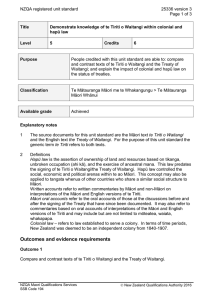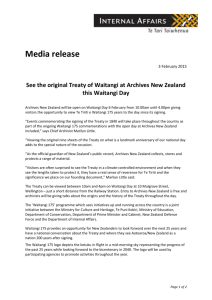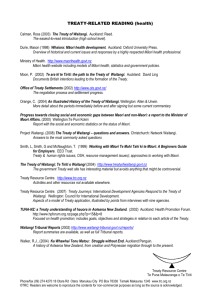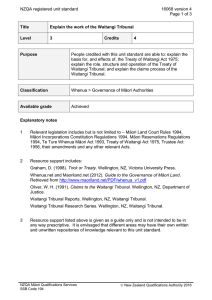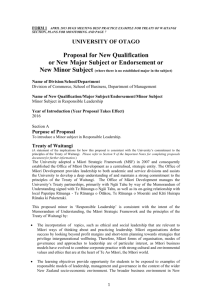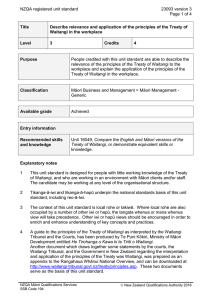NZQA registered unit standard 16078 version 4 Page 1 of 4
advertisement
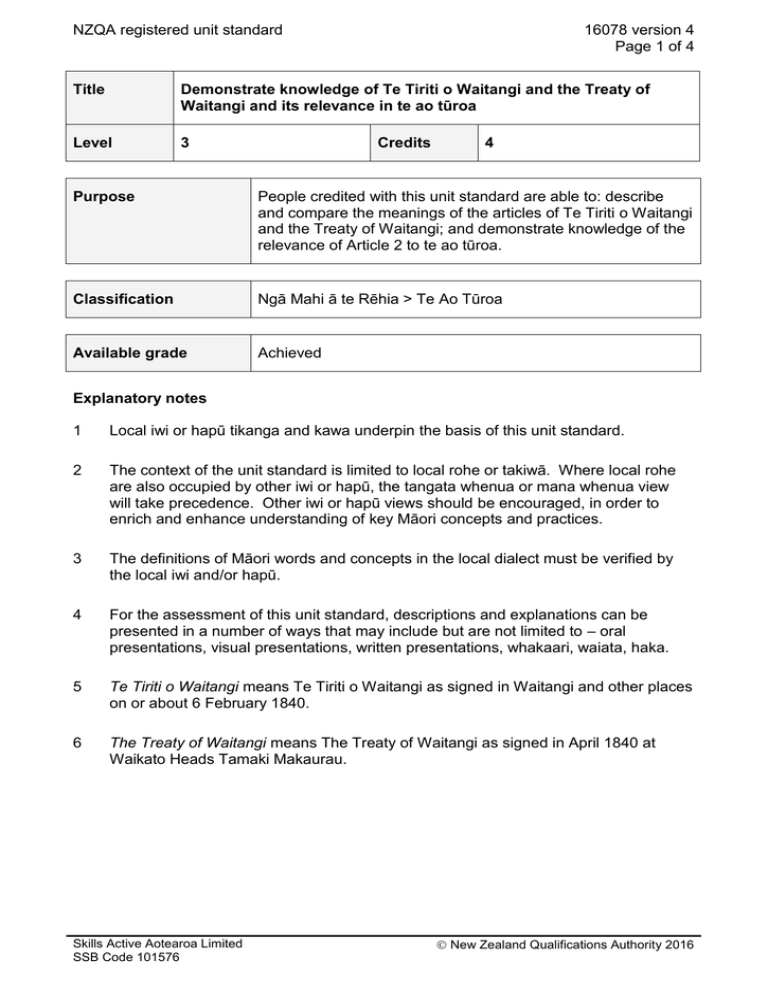
NZQA registered unit standard 16078 version 4 Page 1 of 4 Title Demonstrate knowledge of Te Tiriti o Waitangi and the Treaty of Waitangi and its relevance in te ao tūroa Level 3 Credits 4 Purpose People credited with this unit standard are able to: describe and compare the meanings of the articles of Te Tiriti o Waitangi and the Treaty of Waitangi; and demonstrate knowledge of the relevance of Article 2 to te ao tūroa. Classification Ngā Mahi ā te Rēhia > Te Ao Tūroa Available grade Achieved Explanatory notes 1 Local iwi or hapū tikanga and kawa underpin the basis of this unit standard. 2 The context of the unit standard is limited to local rohe or takiwā. Where local rohe are also occupied by other iwi or hapū, the tangata whenua or mana whenua view will take precedence. Other iwi or hapū views should be encouraged, in order to enrich and enhance understanding of key Māori concepts and practices. 3 The definitions of Māori words and concepts in the local dialect must be verified by the local iwi and/or hapū. 4 For the assessment of this unit standard, descriptions and explanations can be presented in a number of ways that may include but are not limited to – oral presentations, visual presentations, written presentations, whakaari, waiata, haka. 5 Te Tiriti o Waitangi means Te Tiriti o Waitangi as signed in Waitangi and other places on or about 6 February 1840. 6 The Treaty of Waitangi means The Treaty of Waitangi as signed in April 1840 at Waikato Heads Tamaki Makaurau. Skills Active Aotearoa Limited SSB Code 101576 New Zealand Qualifications Authority 2016 NZQA registered unit standard 7 16078 version 4 Page 2 of 4 Resources – may include but are not limited to: a. b. c. d. e. f. g. h. i. Barlow, C, Tikanga Whakaaro: Key Concepts in Māori Culture, Oxford University Press, Melbourne, 2001. Belgrave, M., Kawharu, M., & Williams, D (Eds)Waitangi Revisited: Perspectives on the Treaty of Waitangi, Oxford University Press, Melbourne, 2004. Consedine, R, & Consedine, J, Healing our History: The Challenge of the Treaty of Waitangi, Penguin, New Zealand, 2001. King, M, The Penguin History of New Zealand, Penguin Books Ltd, Auckland, 2003. Moko Mead, H, Tikanga Māori: Living by Māori Values, Huia Publishers Wellington, NZ, 2003. Neumann, R, Our Treaty: The Treaty of Waitangi 1840 to the Present, New House Publishers, Auckland, 2002. Neumann, R, Harrison, Lynn, and Te Kapunga, Winiata,Te Mana o Te Tiriti: The Living Treaty, New House Publishers, Auckland 1990. Orange, C, The Story of a Treaty (reprint 2006), Bridget Williams Books, Wellington, 2004. Tauroa, H, Healing the Breach: One Māori’s perspective on the Treaty of Waitangi, Collins, Auckland, 1989. Outcomes and evidence requirements Outcome 1 Describe and compare the meanings of the articles of Te Tiriti o Waitangi and the Treaty of Waitangi. Evidence requirements 1.1 Description defines the meaning of the articles in terms of rights, responsibilities and privileges conferred on and retained by the signatories. 1.2 Te Tiriti o Waitangi is compared with the Treaty of Waitangi in terms of differences in interpretation of the articles. 1.3 Different Māori and Crown intentions in signing Te Tiriti o Waitangi are described in accordance with Māori and Crown oral and written sources. Range a minimum of two Māori oral and written sources and two Crown oral and written sources. Outcome 2 Demonstrate knowledge of the relevance of Article 2 to te ao tūroa. Range Te Tiriti o Waitangi and the Treaty of Waitangi. Skills Active Aotearoa Limited SSB Code 101576 New Zealand Qualifications Authority 2016 NZQA registered unit standard 16078 version 4 Page 3 of 4 Evidence requirements 2.1 The relevance of Article 2 to te ao tūroa is described in terms of rights, responsibilities and privileges. 2.2 The concepts of natural and physical resources as taonga and kaitiakitanga are described in accordance with local iwi and hapū tikanga and kawa and related to the application of Article 2 in te ao tūroa. Range a minimum of one example of taonga and one example of kaitiakitanga. Planned review date 31 December 2015 Status information and last date for assessment for superseded versions Process Version Date Last Date for Assessment Registration 1 21 May 1999 31 December 2012 Review 2 18 October 2001 31 December 2012 Rollover and Revision 3 23 February 2007 31 December 2012 Review 4 15 September 2011 N/A Consent and Moderation Requirements (CMR) reference 0099 This CMR can be accessed at http://www.nzqa.govt.nz/framework/search/index.do. Please note Providers must be granted consent to assess against standards (accredited) by NZQA, before they can report credits from assessment against unit standards or deliver courses of study leading to that assessment. Industry Training Organisations must be granted consent to assess against standards by NZQA before they can register credits from assessment against unit standards. Providers and Industry Training Organisations, which have been granted consent and which are assessing against unit standards must engage with the moderation system that applies to those standards. Requirements for consent to assess and an outline of the moderation system that applies to this standard are outlined in the Consent and Moderation Requirements (CMR). The CMR also includes useful information about special requirements for organisations wishing to develop education and training programmes, such as minimum qualifications for tutors and assessors, and special resource requirements. Skills Active Aotearoa Limited SSB Code 101576 New Zealand Qualifications Authority 2016 NZQA registered unit standard 16078 version 4 Page 4 of 4 Comments on this unit standard Please contact Skills Active Aotearoa Limited info@skillsactive.org.nz if you wish to suggest changes to the content of this unit standard. Skills Active Aotearoa Limited SSB Code 101576 New Zealand Qualifications Authority 2016
